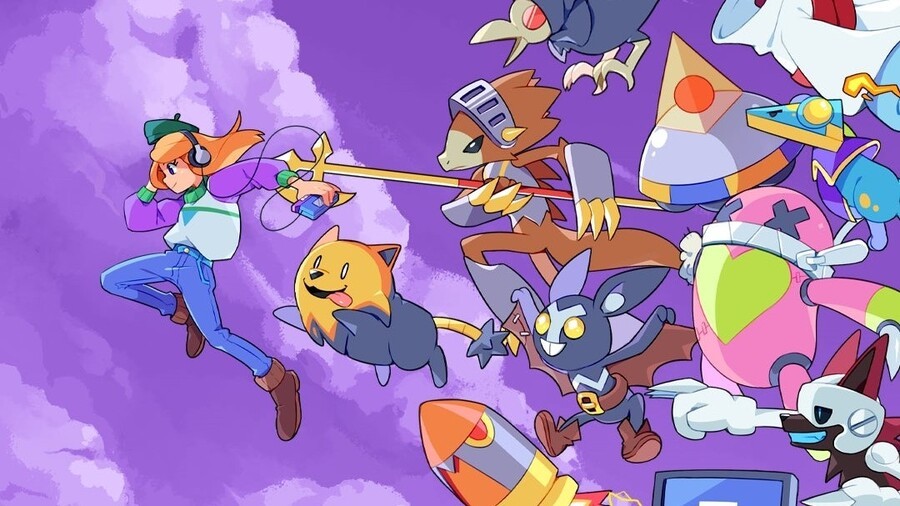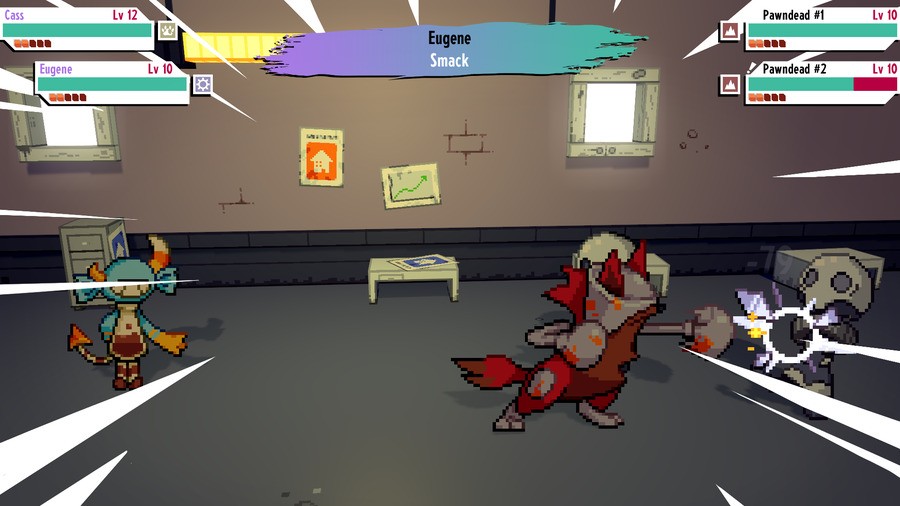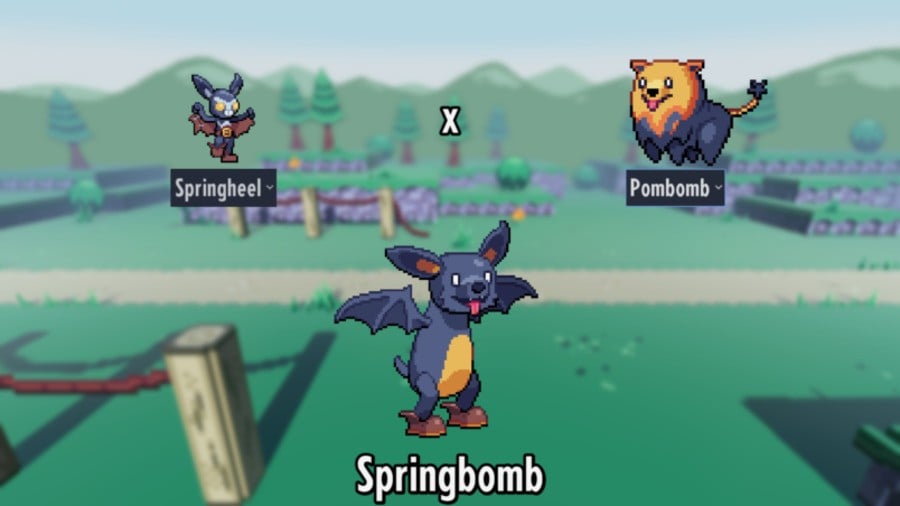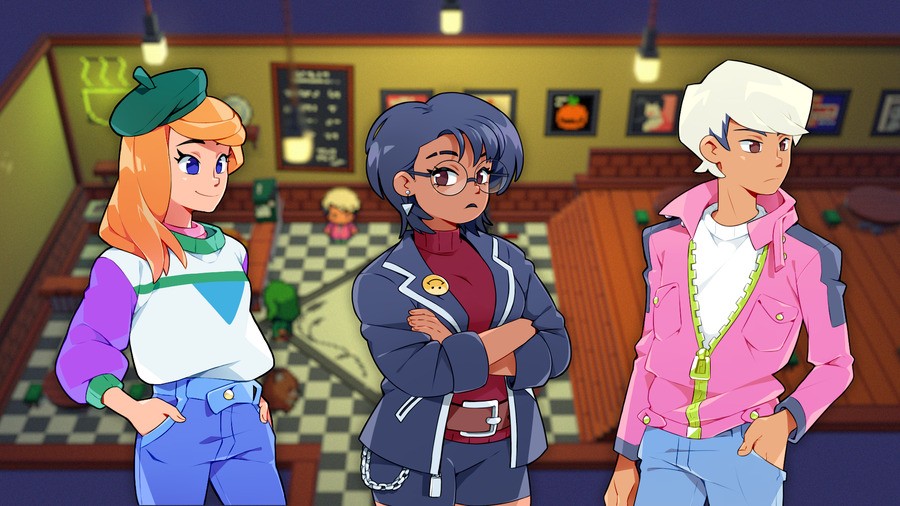
“How can two people make a monster-collecting game that does stuff that Pokémon doesn’t do?”
This question was at the forefront of Jay Baylis and Tom Coxon’s early discussions on what would later become Cassette Beasts, a creature-collecting RPG with an emphasis on good tunes that launches on Switch on 25th May. The duo makes up Bytten Studio and has some experience under their video game belts, as both Baylis and Coxon previously worked on games such as Wargroove and Starbound over at Chucklefish. Together, they’re now tackling a genre dominated by that multimedia powerhouse, Pokémon.
Cassette Beasts obviously draws a lot of comparisons and inspiration from Pikachu and friends: you explore a world filled with over one hundred different monsters that you turn-based battle against, adding the ones you like to your team along the way. They also evolve, or ‘remaster,’ into more powerful forms. We played the demo on Steam (there isn’t one for Switch, at least not yet) and loved every minute of it. In particular, we enjoyed how the overworld took cues from The Legend of Zelda: A Link to the Past, which Baylis confirmed served as the primary blueprint for the denseness of their map and how they approached traversal abilities.

Baylis also didn’t shy away from those comparisons to Pokémon as we sat down for our call, stressing they wanted to take what people liked most about the genre and then move forward with how they could make Cassette Beasts different and unique.
“A lot of people will look at a game that has similarities and say, ‘that’s a Pokémon clone’” he tells us. “But you don’t get that with Metroidvania games; a lot of those games are very similar to Castlevania in a way that we are not to Pokémon.” It strikes Baylis as strange that people aren’t put off from making or buying first-person shooters when Call of Duty exists, so why is that the case with the monster-battler outside of a flood of shovelware on Steam and a handful of indie-developed titles?
To differentiate and innovate in a resource-intensive genre is a monumental task for two people. What could be their 'thing' to set them apart?
For Baylis, the answer was simple: fusions. With an interest in using art in unique ways through the video game medium, the duo came up with the idea to combine creatures together procedurally; every monster in the game, of which there are 120, can combine with every other monster to create a powerful fusion.
As you might imagine, designing and animating so many critters that also need 120 other animated forms each (yes, monsters can fuse with their own species) is impossible with over 14,000 theoretical combinations. Luckily, they had the experience and technological know-how to make it happen.

“[Our] procedural system animates every monster twice. The second time is the fusion form. It’s as if every monster has an action figure and a Lego version, where you can swap parts around. The fusion system mixes the parts on the modular sprite version, and as a consequence, they’re all fully animated and have attack animations. As far as I’m aware, we’re the only game to have done that [in this genre].”
It’s a much more involved system than the cursed Pokémon fusion website, which simply switches the face of one Pokémon for another. We, of course, had to ask if certain monsters wind up becoming hideous or humorous amalgamations in much the same way. Baylis confirmed that this is indeed the case, that some monsters you’d expect to look awesome together can look silly, while two cute critters might end up looking pretty cool. Baylis emphasised that the order also matters: the microphone-wielding Sirenade combined with the fiery Pombomb will make a Sirenbomb that looks different than the reverse, a Pomenade. The base monster designs are great, too. Traffikrab, a traffic cone-wearing crab, and Dandelion – you can guess what it looks like – gave us a laugh when we stumbled upon them.
Outside of fusions, Baylis and Coxon designed other aspects of Cassette Beasts to appeal to slightly older players that grew up with forgiving, kid-focused monster battlers, like Pokémon or the Digimon World games.
“Maybe [these players] want a game that tackles this genre with an adult slant to it," says Baylis. "I mean, one of the key things is that all our characters are young adults rather than teens or children. The world of Pokémon is like an idyllic fantasy escapism. We wanted to do something with a bit more maturity. [In Cassette Beasts], the characters themselves turn into monsters so they keep centre stage, which means they’re interesting and you can develop a story [around them].”
Your partner characters expand on the idea of journeying with your friends, which Baylis wanted to tap more into. You’re never alone in Cassette Beasts, taking someone along with you whenever you head out into the world; as your relationship with your partner grows, you befriend or can romance them. Relationship level powers up the strength of your fusions with your partner, but the romance itself has no mechanical benefit: it’s all part of a more mature roleplay. You can also opt to play local co-op with a real-world friend instead.

Bytten has also experimented with difficulty. While Baylis believes your first playthrough of Cassette Beasts won’t be too challenging if you follow and learn the game systems instead of swerving off the recommended path, upon beating it (or unlocking with a secret code if you prefer, although they do want to encourage a regular run first) custom game modes and settings become available. Adjusting the complexity of enemy AI, level scaling, and a hardcore ‘Nuzlocke’ mode are just the beginning.
“We have a really crazy custom game mode where you can randomise move pools on monsters, but also types and locations,” he elaborates. “So you could run a really insane New Game+, where Traffikrab is fire-type and only appears in end-game areas. Your starter is entirely different and a different type with other moves than usual.”
There seems to be less hand-holding, too. “You can get into late-game areas early by being very good at the battle system. Beating enemies ten levels above you by mastering statues, stuff like that.” Baylis and Coxon have been speedrunning the game, beating it faster and faster – but then again, they’re the developers. Playtesters have reached upward of 60 hours clearing Cassette Beasts exploring every dungeon and recording all the monsters onto cassette tapes.
We’re of the opinion that this genre works best on a handheld, and after wrapping up our desktop demo, we couldn’t wait to give Cassette Beasts a go on Switch, lounging on our sofa the same way we did with every monster collector from time immemorial, including all of Game Freak's. At the end of our interview, Baylis once again emphasised that he’s not against the comparison to Pokémon.
"We love Pokémon, sure, but we’re not making a game meant to be a tribute or derivative. We see Cassette Beasts as an attempt to make something very new in the space; people will be quite surprised to see how different it truly is.”
Cassette Beasts releases on PC today, 26th April, and is launching on Nintendo Switch on 25th May. We will, of course, have a review ready to see how this promising monster-battler fares on Nintendo’s hybrid console.





Comments 30
What Pokémon doesn't... Have a lame art style? I'm no Pokémon fan but those games look nice and always have. This looks like a teenagers sketchbook who isn't very talented.
Fusions are incredibly ambitious, hopefully it works for them.
Is that bat creature wearing shoes?
@Poodlestargenerica Really?! I think it looks great; kind of a modern taken on the 'classic' Pokémon aesthetic.
Different strokes for different folks though, of couse.
@Ryu_Niiyama LOL!! Why yes it is. They are flying bat shoes!!
I hope people don't take these comments as an excuse to say that Pokémon is inherently inferior; it really doesn't feel like it's the developers' intent.
Nice discussion, want to at least try this game eventually after it is released on Switch as it seems like an interesting twist on Pokémon!
@NewAdvent The pixel art is fine. I guess if the terrible drawings aren't part of the game then nobody has to look at them.
This game looks like the very definition of "just because you can, doesn't mean that you should".
I might give it a... ah who am I kidding my backlog is never going to be finished.
First thing is Pokemon have personality .. they have a show too that you get to know em more than just the game... storylines, etc. Not so much for those other examples he mentioned.
Second, fusion has been done at a high level in crypto games. Blockchain Cuties has a whole genome and structure on breeding different offspring. And very talented artist and design that created a system to fuse parts of each aspect to make new interesting offspring.
I think it looks pretty nice. I'll try it on game pass.
At least a little bit better than Temtem, Nexomon, Monster Viator, and all the other Digimon clones.
Instant buy! Sounds awesome, whereas I've never been interested in Digimon or Nexomon. But it looks like this one looks and plays differently.
“…people will be quite surprised to see how different it truly is.”
Said basically every Pokémon clone dev ever.
"A lot of people will look at a game that has similarities and say, ‘that’s a Pokémon clone'. But you don’t get that with Metroidvania games"
Agree with this. Pokemon fans act like Game Freak has a ownership over the monster-collecting genre when Pokemon wasn't even the first game to do that.
There’s definitely space now for someone to challenge Pokémon but I think the 2D DS era is what I’d aim for personally.
It sounds interesting, but that first screenshot immediately put me off
Despite the negative comments, Im excited to give this a shot, a more mature pokemon sounds interesting and the artstyle doesn't erk me as much as it seems it does for some others here, plus, I really like fusions as a concept, with infinite fusion being one of my favourite games ever
@tenmetresam Upon watching through the trailer, I actually really like the artstyle
@Poodlestargenerica Spoken like a true pokemon fanboy.
You should see an optician if you seriously think this looks worse than any of the hideous recent pokemon entries
@Lightjolly I literally said I'm not a Pokémon fan, seems like I'm not the one who needs an optician lol.
@Poodlestargenerica "But those games look nice and always have"
Saying stuff like that, how could I possibly believe you're not a poke fanboy, when pokemon sword/shield and Violet/scarlet are some of the ugliest games on the switch, nevermind the entire series.
@Lightjolly Rest assured that nobody will ever agree with you that this looks as good or better than Pokemon. Absolute nonsense hot take there. You don't have to be a fanboy, you just need to have a pair of eyes.
@Switch_Pro yeah sure buddy, that's why it sits with a higher user score and critic score than all the recent pokemon games, people reeeeeeeally dont like it
@Lightjolly Indie games and high profile releases are not judged on the same metric system. If an indie developer made a game as good as Scarlet/Violet, it would be in the 90s and proclaimed to be the Pokemon killer. Also, there are only a handful of Metacritic reviews, usually from sites that enjoy indie games to begin with. You have no idea what you are talking about dude. The two games are not even in the same universe of quality and relevance.
@Switch_Pro Not judged on the same metric system? Of course they're not if its convenient for your arguement. The only difference is that high profile games get more reviews because they generate more clicks but they're all reviewed the same, so what are babbling about lmao. If you really want to go down the controversial rabbit hole, I'd say high profile games tend to get away with a lot more than indie games.
Look no ones saying it's a pokemon killer, nothing can kill pokemon, just like hollow knight cant kill metroid despite being better than any recent metroid game or bug fables wont kill paper mario despite being way better than anything that franchise put out in over a decade.
I know it hurts to admit your dear franchise has been pretty mediocre lately and you just dont want to admit it over some silly pride.
In the battle screenshot the monsters look out of place compared to the background for me. I am interested in getting this but it's a hard wait and see for me.
Upon closer inspection there are 3 different levels of pixelation in that battle screenshot that imo don't mesh too well. The sprites, background and the hud.
Edited to better represent what I was saying
"The world of Pokémon is like an idyllic fantasy escapism."
Sorry but I don't agree with that statement. There's more than meets the eye there.
At least the game is looking interesting and technologically advanced, so I'll definitely consider getting it.
Show Comments
Leave A Comment
Hold on there, you need to login to post a comment...